Joy Neal Kidney's Blog, page 78
December 11, 2020
Doris and Darlene Visit France and Belgium and England
Iowa, October 1997
No one in the family has ever been to see where Danny Wilson’s remains lie.
But at age 76, Aunt Darlene announces that while she can, she wants to see “where brother Danny is buried.” Older brothers Delbert and Donald–both living on the West Coast—would like to go too, but they are in their eighties and not sturdy enough to make the trip.
“You and Doris go,” they urge Darlene. But my mother Doris, at 79, hasn’t been on a plane since the war. Even though my dad Warren was also a pilot during the war, after losing her three younger brothers, Mom wouldn’t fly anywhere.
“Joy, you ought to come with me,” Aunt Darlene nudges. “You’ve done all the work on our family history.” Yes, I’d transcribed all the letters and telegrams, researched military records, and even located the only photo of Danny’s wrecked plane. Visiting Danny Wilson’s grave was on my bucket list, but traveling there with one of his sisters seems too wild a dream.
“Mom, I’m going with Aunt Darlene. How are you going to feel, thinking about us at Danny’s grave without you?”
“But I’m afraid I’ll fall and ruin things for everyone.”
Yes, she’s had hip replacement, but after trying out a few more excuses, she eventually agrees to go with us.
Two white-haired farm widows, with my husband and me as support crew, fly to Paris, Doris praying the plane across the Atlantic.
Our travel agent had suggested that since this might very well be Doris and Darlene’s only trip to Europe, they might like to visit Paris.
“Oh, yes,” says Darlene. “I’d like to see the Eiffel Tower.”
“Is Versailles very far?” asks Doris. “We studied that in school.”
“What else?” the agent urges. “Any other countries?”
“How hard would it be to get to London?”
“My grandson has been to Stonehenge,” said Doris, “I’d like to see it, too.”
So, we hire a driver to visit Versailles, the Eiffel Tower, Notre Dame, ride on the Seine, take a day trip to Normandy and Mont St. Michel—Doris with her cane, Darlene plodding with peripheral neuropathy in her legs—all the while thinking of the grave in eastern France, the reason we are there.
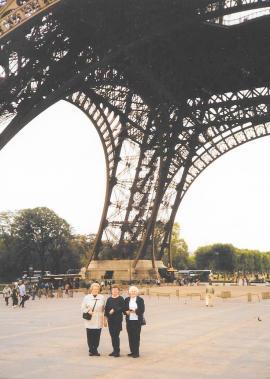

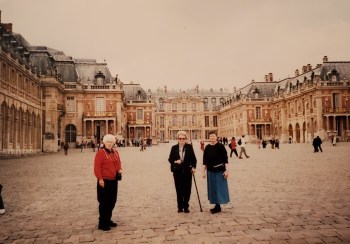
When we arrive at the Lorraine American Cemetery, we place a bouquet of gerbera daisies and roses at Danny’s grave in Plot C, Row 3, just one among row upon row of white crosses and Stars of David–more than 10,000 of them. Under umbrellas in a drizzle, surrounded by lush chestnut groves, we hold our own private ceremony for Doris and Darlene’s younger brother Danny, who was Killed in Action February 19, 1945.

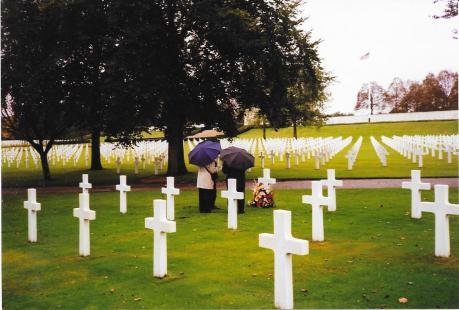
And at the end we sing the words to “Taps.” Still subdued and teary, we travel in steady rain through Luxembourg and Belgium.
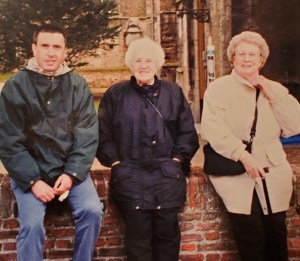
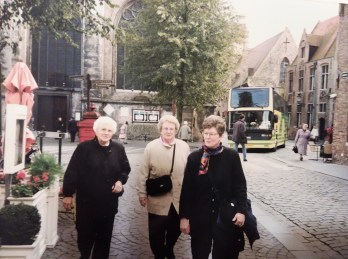
(Alain, our driver through France and Belgium, with Darlene and Doris. Bruge.)
After seeing Bruge and Brussels, we take the Chunnel from Brussels. It is even raining when we get to London.
Sunday morning, the powerful organ and soaring voices at Westminster Abbey’s Sunday service are surprisingly soothing, helping to bring closure to our journey.
The sisters tour the Tower of London, Madame Tussaud’s, and ride on the Thames. One evening, as we sit on flowered chintz counterpanes in our London hotel, Doris says, “Can you believe where we are? We’re sitting in London! Eating Belgian chocolates!”
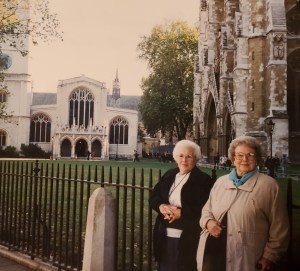
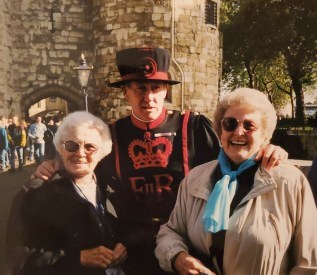
(Westminster Abbey and Tower of London)
“And can you believe,” said Darlene, “that someone in our family has finally been to where brother Danny is buried?”
Well, Doris did take a tumble, just the third day of the trip. It took both my husband and our driver to get her back on her feet. Laughing, she threatened to sue the driver for not taking better care of her. He shot back that he’d have to counter sue for causing him a heart attack.
Doris still had to pray the plane back across that ocean, but she got to see Bath and Salisbury first. We all enjoyed framed pictures of the four of us, under umbrellas, with the sarsens and lintels of Stonehenge behind us.

All because of the tug of a single grave in a far away cemetery.

Lorraine American Cemetery, St. Avold, France. More than 10,000 Americans are buried there, including Danny Wilson of Minburn, Iowa.
December 9, 2020
World War II Legacies by Kayleen Reusser
I’ve enjoyed several of these shorter books featuring World War II veterans and their memories. They would be terrific gifts even for high schoolers.
The Author
After interviewing 250 WWII vets during the past decade, Kayleen Reusser, a 25-year writing professional, has written several books about those veterans and the war, as well as many stories about veterans in magazines and newspapers. She is a military spouse/mother.
After completing a 10-day WWII Tour of Europe, Reusser has put together a talk with photos of places vets served, including Omaha Beach, a foxhole in Belgium used during the Battle of the Bulge, Paris, Hitler’s retreat called Eagle’s Nest, Dachau, etc. She has spoken to dozens of groups of all ages.
[image error]
A former middle school librarian, Reusser has written 17 non-fiction books for that age group for Mitchell Lane and Purple Toad Publishing. Titles include biographies on Meghan Markle and Nobel Peace Prize winner Malala; STEM books on Big Ben and Golden Gate Bridge, Indonesian and Cuban cookbooks, and 3 books on Greek mythology.
I especially liked these short books:
[image error]
My thoughts: During WWII, 120,000 Americans were held as POWs, in Europe and in the Pacific. A devastating 40 percent of the ones held by the Japanese died in captivity–from cruelty, diseases, malnourishment, even killings.
After some background about the war, there are stories about two foot soldiers, one navyman, and five airmen. The airmen were POWs of the Nazis, the other two prisoners of the Japanese. The timeline of the war is at the end of the book.
The author interviewed seven former POWs for these stories, and was given access to the journal of another. These are important stories to contemplate, to remember. One man lied about his age, entering the army when he was only 15. Even when he was released after 41 months, he was still a teenager.
There are compelling Book Club Questions at the end, which would also be good for a high school history class to contemplate. Kayleen Reusser’s short books of stories of WWII veterans would be fine additions to school and other libraries. History through the eyes of those who lived it.
[image error]
My thoughts: I wish I’d had books like Kayleen Reusser’s Witnesses of War Books when I was a schoolgirl. As an adult, I finally discovered that history is people. In this heartwarming slim book, there are stories of eighteen people who witnessed WWII as a child or young adult–everything from being whisked out of London’s nightly bombing raids by Germans in Operation Pied Piper to fleeing from Germans and Russians becoming refugees.
Accompanied by several photos, some by the survivors themselves, two stories are about Resistance Fighters. One girl became a WREN working with top secret codes at Bletchley Park. Another was trapped in rubble with younger siblings after a bombing. Most of the stories have ties to the State of Indiana, but any school children would get a good idea of what it was like to be a child during wartime, and how it affected these individuals as adults.
The book includes Discussion Questions and a World War II Timeline, as do other books in this delightful series.
[image error]
My thoughts: This short book is packed with background history of the war and of D-Day, then begins introducing the stories of seventeen veterans she interviewed for the book. Their sketches begin with a chapter on Fighting on the Ground and continue through one about a chaplain, the inventor of the “Higgins boats,” Fighting in the Air, a POW, Treating the Injured, etc. Several National Archives photos are used in the book, as well as personal ones of the veterans themselves. Toward the end of the book or photos of several of the men recently, holding framed medals and photos or memorabilia and comments about the war.
The last chapters give More Facts about D-Day, a timeline of WWII, and a D-Day Glossary. The Author’s Reflections of D-Day and Normandy are from traveling to Normandy and other war sites. Kathleen Reusser has preserved important history for the rest of us, including the memories of veterans who lived it.
[image error]
This is her latest, Women of WWII Coloring Book, which is only $5 on Amazon.
[image error]
Kayleen Reusser has longer WWII books, also. Check out her Amazon Author Page.
December 7, 2020
December 7, 1941
[image error]
In a gold waitress uniform, Doris Wilson served Sunday dinner to the after-church crowd at McDonald’s Drug store in Perry, Iowa. A hint of Evening in Paris perfume was always in the store. They sold a lot of it. She also worked at the soda fountain, but the restaurant section was always especially busy after church on Sundays.
[image error]
Sammy Kaye’s Sunday Serenade provided background music over WHO Radio. A news bulletin interrupted the music: The Japanese had bombed Pearl Harbor.
“The Japs? Why would they bomb Pearl Harbor?” someone asked.
“Does this mean we’re at war?”
“Where is Pearl Harbor anyway?” asked another.
“Hawaii,” Doris said. “I’m afraid this does mean war. And my brothers are all the wrong ages.”
“How many brothers do you have?”
“Five. Donald is already in the Navy. His ship was stationed in Pearl Harbor a few months ago. He said we shouldn’t trust the Japs, and he was right.”
Thank God Donald had jumped ship a couple of weeks earlier to return to the Minburn farm to see the family. With war breaking out for real, who knew when they’d all be together again?
And thank God Danny was too young to be drafted, and Junior was still in high school at Washington Township School. But Delbert would probably be recalled by the Navy, and Dale had already registered for the draft. Donald wasn’t safe in the Atlantic either. Doris feared for all five brothers.
President Roosevelt had made a prophesy back in 1936, “There is a mysterious cycle in human events. To some generations much is given. Of other generations much is expected. This generation of Americans has a rendezvous with destiny.”
He was right. And Doris was right.
One by one her brothers volunteered until all five had left the Minburn farm were in military service. That generation of the Wilsons, having endured poverty during the worldwide Depression, was destined to suffer the anguish of losing three brothers during a world war.
The family’s WWII story is told in Leora’s Letters: The Story of Love and Loss for an Iowa Family During World War II. It’s the story behind the five brothers featured on the new Dallas County Freedom Rock at Minburn, Iowa.
[image error]
December 5, 2020
The Mustard Seed
I don’t know where she got it, whether she bought it herself, or maybe it was a gift.
Leora’s mustard seed pendant.
[image error]
She read her King James Bible and had been baptized, as an adult, at the Methodist Church in Dexter. I vaguely remember her wearing the mustard seed charm on a chain as a necklace.
It’s not very attractive. The metal crown has tarnished and the bauble itself is murky. But the little seed is unmistakable.
Why was this small novelty important to her?
Perhaps because of Mark 4: 30-32: “And He said, ‘How shall we picture the kingdom of God, or by what parable shall we present it? ‘It is like a mustard seed, which, when sown upon the soil, though it is smaller than all the seeds that are upon the soil, yet when it is sown, it grows up and becomes larger than all the garden plants and forms large branches; so that the bird of the air can nest under its shade.'”
In other verses, Christ likens a mustard seed to the size of a person’s faith.
[image error]
I wish I’d asked Grandma about her mustard seed. It just might represent the faith she had that she would see her sons again, the ones lost during WWII, and her husband one day in heaven. It may have helped her find enough faith in God to face other day.
Grandma was a delightful, cheerful woman all the decades I got to share with her. The little mustard seed reminds me of that and that I’ll get to see her against someday.
It has become a treasured memento on our Christmas tree.
The only thing better than an heirloom is an heirloom with a story. – Joy Neal Kidney
December 4, 2020
Danny Wilson’s Wrecked P-38 Lightning
A couple of decades ago I wrote the Bergermeister of the Schwanberg, Austria, where Danny Wilson lost his life in 1945.
Dir. Alois Ircher answered my letter and, when he learned how I was related to the only American buried in their cemetery during World War II, he sent me a copy of a history of Schwanberg. It’s in German.
[image error]
[image error]
The book doesn’t have a copyright date, but the short sketch goes through 1981.
[image error]
Danny Wilson’s wrecked Lightning is pictured on page 41. The date is wrong, as the crash occurred on February 19. I cringe to look at it. I never showed it to Mom or Aunt Darlene. In fact, this is the first time I’ve published this photo.
[image error]
Dan Wilson was not shot down, as we took for granted. Dr. Ircher said his plane was so low that it hit a telephone or light pole. He said that where the plane fell is now a “sportplatz.” He doesn’t know what the German occupiers did with the remains of the plane.
The main mission of the 37th Fighter Squadron, 14th Fighter Group, 15th Air Force that day was was to escort B-24s of the 55th Wing at Bruck, Austria. On their way back to their base at Triolo, Italy, the P-38s were strafing (and an experimental skip-bombing) in the Graz area of Italy.
December 2, 2020
Soldiers’ Stories: A Collection of WWII Memoirs, Volume II compiled by The Miller Family
The Book
[image error]
For over five years the Miller Family, Myra Miller, PhD, Ken Miller, Del Miller, Marshall Miller, and Lynette Miller Ballard, have zealously gathered memoirs of World War II servicemen and servicewomen. In 2016 they published Soldiers’ Stories: A Collection of WW II Memoirs. Now, on the 75th anniversary of the end of the war, they have given us a second volume.
Were it not for the Miller Family, most of these stories would not have seen the light of day. Tom Brokaw popularized the phrase “The Greatest Generation.” Read the stories and you will see why the title is deserved by all 16 million men and women who served so proudly.
Here are the mysteries of courage, the terrors of violence, and the cruelties and coincidences of war. Here, also, are reminders of the humorous events and day-to-day life of those war years. Our first book collected stories our father told us and accounts of other WWII veterans. More narratives demanded a second volume.
History is alive. As any veteran will tell you, our future depends on the choices we make now, choices based on our understanding of the past and the meaning of war. Each person’s story speaks of the precious gift of life and our common humanity beyond national borders.
The Authors
As the proud children of Myron H. Miller, S/Sgt, 83rd Infantry Division, K/331st, pooled their talents and skills to create this second beautiful volume of memoirs: with Myra Miller, PhD; Ken Miller, illustrator; Del Miller, Marshall Miller, and Lynette Miller Ballard as writers and editors.
My Thoughts
I was so taken by the first handsome volume of soldiers stories that I submitted stories for this one. The Wilson family story is laid out so well across eleven pages of this treasure. Five brothers served. Only two came home.
There are stories of men and women from every branch of the service, some who survived, some who did not. The memoirs are written by the veterans themselves, by family members, or interested friends. There are stories about the Manhattan Project, Red Cross workers, Rosie the Riveter, men who have adopted the overseas graves of American fallen, even one who found dog tags in Belgium and did the research to find family members. One veteran is honored by his 12-year-old grandson. Michelle Obama’s grandfather’s service is also documented.
As a follower of G. P. Cox’s Pacific Paratrooper website, I was delighted to find four pages dedicated to WWII stories of his father.
This superbly crafted oversized volume of personal histories would be a fine gift for any history or World War II enthusiast.
November 30, 2020
Leora Wilson’s Decision to Have Danny Wilson Buried Overseas
[image error]
The survivors, October 1946: Delbert Wilson, Darlene (Wilson) Scar, Doris (Wilson) Neal, Donald Wilson (still in the Navy). Rural Perry, Iowa.
Newspaper clipping, probably from The Des Moines Register or Tribune.
[image error]
Decision of Returning War Dead Put Up to Relatives
Given Time For Thought
WASHINGTON, D. C. (AP)–Should the remains of Americans who died abroad in World War II be brought home for burial?
Their families are not making a snap decision on this, but three-fourths of those the government has heard from say yes.
Congress has authorized bringing the bodies back to this country at government expense if the relatives desire.
Letters.
The war department quartermaster corps sent out its first 20,000 letters of inquiry to the next of kin of soldiers, sailors and marines early in March.
So far it has had fewer than 1,000 replies. But more than 75 per cent of these want the dead to lie in U. S. ground.
Maj. Gen. Thomas B. Larkin, the quartermaster general, is charged with the responsibility of carrying out the program. He had hoped to see it begin in August. But now it is believed it will be September or October before it starts.
Indecision.
This is because of difficulty in getting coffins, locating the next of kin–many of whom have moved–and the seeming indecision of the living.
That families take their time to decide–talk it over with relatives and the clergy, if desired–is approved by the war department. It is seen as a question not to be answered quickly or without thought.
America’s overseas dead in World War I totaled about 51,000, of whom nearly 60 per cent were brought home for burial.
Toll.
In World War II the toll was 385,000. About 24,000 bodies have not been recovered.
The war department estimated that 80 per cent of the relatives would want remains returned. It is possible this estimate may be revised downward.
Within the next 10 days, the war department plans to release a list of those buried in Hawaii; St. Laurent, France; Henri Chapelle, Belgium; Cambridge, England; Nettuno, Italy; Gela, Sicily; and at Casablanca, Gafsa and Tunis, North Africa.
The first bodies will be brought back from these areas.
The present intention is to return first the bodies of those buried in Hawaii, the target of the first bombs to fall on American territory in the last war. A few days later shiploads will be coming from Europe.
Cemeteries.
America’s war dead have ben buried in 209 temporary cemeteries. some of these will be made into permanent resting places for those whose relatives decide against bringing them back to this country.
In this decision the war department is neutral. But a new army movie short, “Decision,” which shows a family going through the return of a loved one, seeks to warn what the strain will be.
Mrs. George Patton does not intend to disturb the grave of the colorful third army commander, who died in an automobile accident in Germany and was buried at Hamm, Luxembourg.
In a “letter to the American people” published in the Congressional Record she said, “What will come home to you isn’t what you remember and love.”
Leora had also found a clipping that stated that soldiers, if given a choice, would prefer to be buried where they fell. She’d endured two recent funerals, for Junior and for Clabe. It looked like Dale might never be found. So, talking it over with family members, she decided not to bring Danny home.
[image error]
It would be decades before anyone in the family made the trip to St. Avold, France, to see his grave. (Story scheduled for December 11.)
[image error]
Leora Wilson, counting some of her blessings. Grandchildren Robert Scar, Joy Neal, Donna Wilson, Leora Darlene Wilson, Richard Scar. October 1946, rural Perry.
[image error]
Back: Delbert and Evelyn Wilson, Warren Neal, Grandmother Laura Goff. Front: Joy Neal, Donna and Leora Darlene Wilson, Doris Neal with Gloria. Probably spring 1947, rural Perry.
Delbert and Evelyn Wilson would later have a son, and Darlene and Sam Scar would have two more sons. Of the nine grandchildren of Leora Wilson, five are still living: Richard and Robert, Leora Darlene, Joy and Gloria.
November 27, 2020
I Didn’t Tell My Mother (poem)
I Didn’t Tell My Mother
. . . about my ride in this old plane,
like the bomber in which
her brother Dale lost his life
six decades earlier.
The B-25 rushes and roars down
much of the Des Moines runway, then lifts.
I tried to imagine Dale Wilson
in the cockpit, age 22, the copilot. . .
Aloft, engines clatter in the wind.
. . . his last mission, his thirteenth, over
the jagged Owen Stanley Mountains,
the jungles of New Guinea,
and the antiaircraft guns of Wewak,
the town named on the telegram
that would echo down long decades. . . .
The Mitchell bomber turns, growling
over Madison County farms and fields.
Too soon wheels grind down,
engines grumble lower.
. . . for the families of six young men
whose timelines on this earth
were severed when Bomber #4889
became their underwater coffin.
Tires scrunch and screech
against the tarmac,
spewing rubbery smoke
through empty windows.
(2005)[image error]
—–
This is the anniversary of the loss of Dale Wilson and five others on a mission in 1943.
November 26, 2020
Thanksgiving Menus from the USS Yorktown (CV-5)
Donald Wilson served on the USS Yorktown (CV-5) “her whole life,” having joined the crew before commissioning. Here are a couple of Thanksgiving menus he mailed home to his folks, Clabe and Leora Wilson, who were tenant farmers at Minburn, Iowa.
1939
[image error]
[image error]
1940
[image error]
[image error]
I wish the menus showed up better. They are quite similar, except for the location of the aircraft carrier.
November 25, 2020
Ancestry Line to The Mayflower
Elizabeth Tilley, born in England in 1607, came to the New World on the Mayflower in 1620 with her parents, John and Elizabeth Tilley. She was orphaned that first winter at Plymouth, Massachusetts, when her parents died. Gov. and Mrs. John Carver took her in.
She married John Howland, who’d been washed overboard when the Mayflower encountered a storm, but was caught in the halyards and rescued. He was the bond servant of Gov. Carver, signed the Mayflower Compact, earned his freedom, and was a well-respected citizen.
[image error]
Their daughter Desire married John Gorham, who was killed in King Phillip’s war, even though he wasn’t a soldier.
Nantucket
Son Shubael Gorham married Puella Hussey in 1695 on the island of Nantucket. Their daughter Lydia married Joseph Worth of Nantucket.
North Carolina
Joseph and Lydia Worth’s son Daniel married Eunice Hussey. Son David Worth was the ancestor of C. E. Charles. Another son, Job Worth, married Rhoda Macy in Guilford County, North Carolina.
Indiana
After their daughter Rhoda married Sylvanus Swain, they moved to Wayne County, Indiana. Daughter Cynthia married Thomas Marshall. Thomas Marshall didn’t move to Dallas County, Iowa, with the exodus from Wayne County, although his father, Miles Marshall, brothers, and a son and daughter did.
[image error] [image error]
Thomas Marshall. His house still stands near Economy, Wayne County, Indiana.
Iowa
Thomas’s daughter Rhoda married John Neal, who’d fought for the Confederacy, deserted, then joined the Union. They moved to Dexter, Iowa, after the Civil War.
John and Rhoda Neal had six children, five daughter, then a son, Orlando Swain Neal.
[image error]Seated: Rhoda, Orlando Swain, and John Neal
O. S. Neal married Nellie Keith. They were my father’s grandparents, but my stories about them came from my mother, whose family lived in Dexter near by during the scarcity years of the Great Depression.
O. S. and Nellie Neal had three sons and one daughter. My grandfather Kenneth was the middle son, but anyone who descends from any of these folks, had ancestors who came over on the Mayflower.
[image error]Neals: O. S., Marjorie, Kenneth, Nellie, Keith, and Maurice (Marjorie’s twin)
Kenneth Neal married Ruby Blohm at Dexter, and my father, Warren Neal, was their oldest child.
[image error]Kenneth, Warren, and Ruby Neal
This is just a sketch of my connection to the Mayflower.
Sources: Nantucket Vital Records, Mayflower Society, Civil War records



